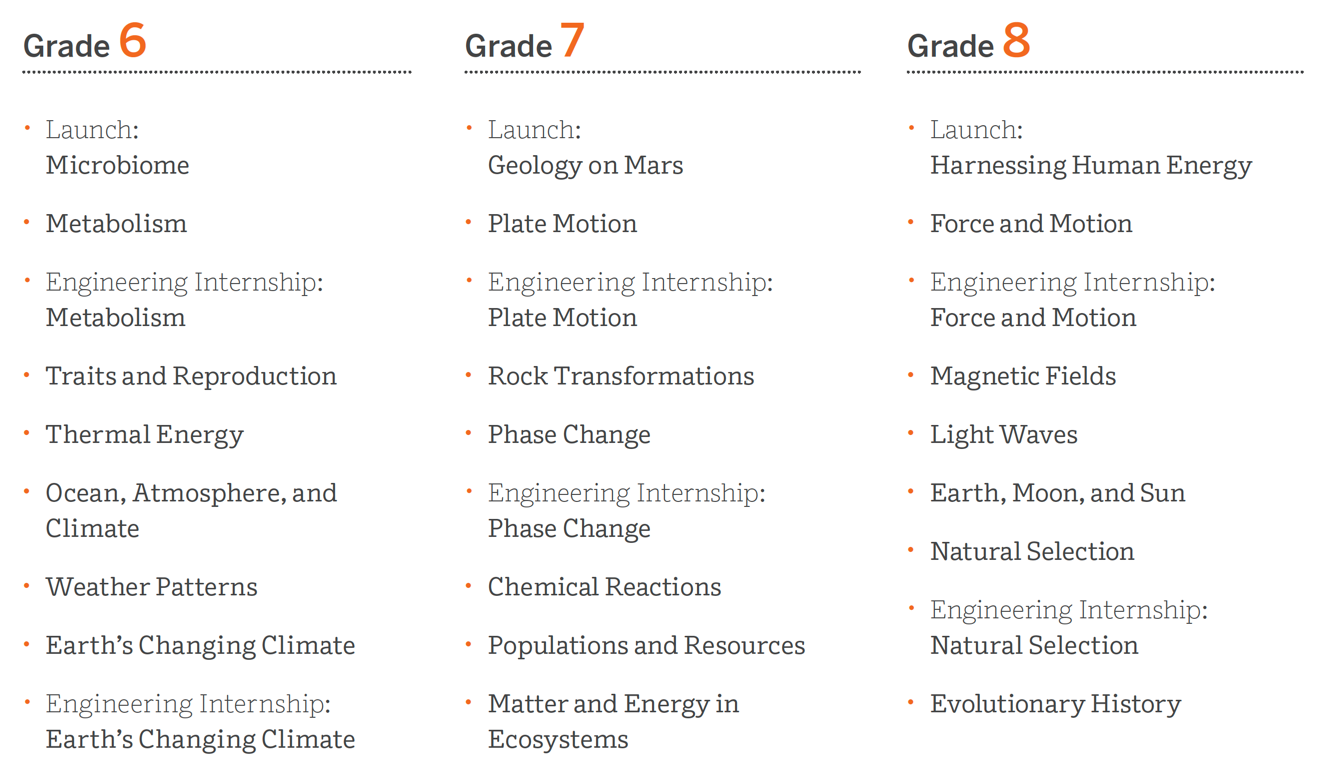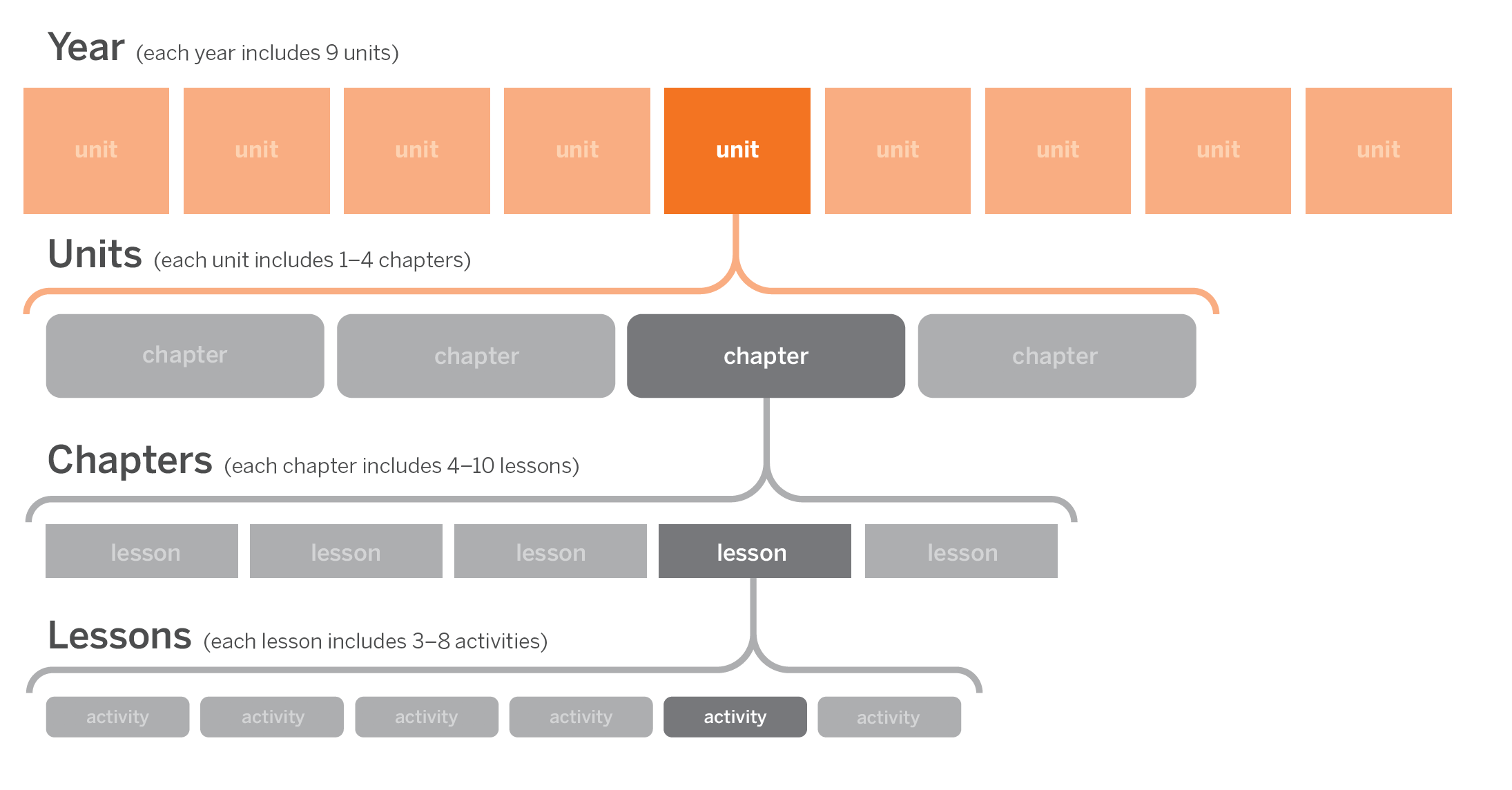Grade 6 – 8 (Integrated Model)
Each course (or “year”) of Amplify Science for grades 6–8 consists of nine units. An example of how the units can be distributed amongst each of the grade levels is provided here, but schools have full discretion to order the units into any sequence that is appropriate for their district. Each unit contains 10–19 lessons, each of which was written for a 45-minute session — though teachers can expand or contract the timing to meet their needs. The number of lessons in a unit depends on the unit type, which is explained in more detail below.
Example integrated sequence:

Navigation structure:
The curriculum is intuitively organized and easy to navigate. Courses/Years contain units, which contain chapters, which contain lessons, which contain activities.

There are three types of units in Amplify Science grades 6–8: Launch, Core, and Engineering Internships. Each year has one Launch unit, six Core units, and two Engineering Internships.
Launch units
Launch units are the first unit taught in each year of Amplify Science. The goal of the Launch unit is to introduce students to norms, routines, and practices that will be built on throughout the year, such as argumentation and Active Reading, as well as the use of the Amplify Science technology. For example, rather than taking the time to explain the process of Active Reading in every unit in a given year, it is explained thoroughly in the Launch unit, thereby preparing students to do active reading in all subsequent units.
- Each Launch unit contains a total of eleven lessons.
- There is one Launch unit for each grade or domain.
| Grade (suggested) | Launch unit |
|---|---|
| Grade 6 | Microbiome |
| Grade 7 | Geology on Mars |
| Grade 8 | Harnessing Human Energy |
Core units
The majority of units in a course are Core units, which guide students in constructing a deep understanding of important science concepts by using key practices of science and engineering. A Core unit begins by establishing the context of the unit by introducing students to the real-world problem they will be investigating.
As students move through lessons in a Core unit, they will figure out the unit’s anchoring phenomena, gaining an understanding of the unit’s disciplinary core ideas, developing experience with the science and engineering practices, and making linkages across topics through the crosscutting concepts as they do so. Students will be doing hands-on activities, recording observations from digital Simulations, annotating scientific articles, watching engaging media, crafting visualizations of their understanding via the modeling tools, participating in exciting classroom conversations, drafting persuasive scientific arguments, and completing a variety of formative assessments along the way, giving teachers insight into student growth over the course of the unit.
Each Core unit culminates with a Science Seminar and final writing activity, giving students the opportunity to apply what they’ve learned throughout the course of the unit. In these sequences, students explore a new real-world problem, collect and analyze evidence, and then debate which claims are best supported by evidence, all while making clear their reasoning that connects the evidence to the claims. Finally, each student individually crafts a final written argument.
- Each Core unit contains 16 lessons, which are divided between four chapters.
- In addition to the 16 lessons, each Core unit also includes three formal assessment days: a diagnostic Pre-Unit Assessment, a mid-unit Critical Juncture Assessment, and an End-of-Unit Assessment (i.e. 19 sessions total per Core unit). There are also numerous unobtrusive, formative assessments interspersed throughout the unit.
| Grade (suggested) | Core units |
|---|---|
| Grade 6 | Metabolism Traits and Reproduction Thermal Energy Ocean, Atmosphere, and Climate Weather Patterns Earth’s Changing Climate |
| Grade 7 | Plate Motion Rock Transformations Phase Change Chemical Reactions Populations and Resources Matter and Energy in Ecosystems |
| Grade 8 | Force and Motion Magnetic Fields Light Waves Earth, Moon, and Sun Natural Selection Evolutionary History |
Engineering internship units
21st-century science students need deep dives into the application of science in real life and how it is instrumental in addressing major challenges that confront society today. Each Engineering Internship unit of Amplify Science therefore asks students to design solutions for a real-world problem requiring them to figure out how to help those in need through the application of engineering and design practices. The units emphasize compassion, sympathy, and the consideration of the needs of diverse peoples, from tsunami victims in Sri Lanka to the special needs of premature babies.
The Engineering Internship units invite students to take on the role of engineering interns in a fictional company called “Futura Engineering.” In the first lesson, a fictional project director appears in a video to introduce students to their design challenge and to present them with essential background information. Importantly, this is also where students are introduced to the competing design criteria and limiting constraints they will need to balance in their designs. Students quickly learn that in the Engineering Internships, there is no one “right answer.” Rather, they will need to work together to iteratively design the best solution that can be justified through the data they have collected.
- Each Engineering Internship unit is designed to follow an associated Core unit. For example, the Force and Motion Engineering Internship would follow the Force and Motion Core unit, giving students an opportunity to apply what they learned about forces and collisions to an authentic problem—designing an emergency supply drop pod.
- The Engineering Internship units each contain a total of ten lessons.
| Grade (suggested) | Engineering Internship units |
|---|---|
| Grade 6 | Metabolism Engineering Internship Earth’s Changing Climate Engineering Internship |
| Grade 7 | Plate Motion Engineering Internship Phase Change Engineering Internship |
| Grade 8 | Force and Motion Engineering Internship Natural Selection Engineering Internship |
Coding Science Internship unit
At a time when schools are taking a closer look at integrating computer science in grades K–12, science teachers have limited resources, and most computer science education, when it exists, happens in high school. The Coding Science Internship, or CSI, offers an introduction to programming designed specifically for middle schoolers and supports middle school science teachers whether or not they have a programming background
Like Engineering Internship units, the Coding Science Internship is ten lessons long and is structured around a simulated internship. Instead of focusing on engineering challenges, however, the CSI is designed to engage middle school students in code-to-learn experiences within a visual programming environment. Coding-to-learn positions programming and computational thinking as practices and cognitive tools to learn on the way to achieving other meaningful goals. By integrating coding within core science courses and engaging students in authentic discourse and collaboration structures to solve compelling real-world problems, Coding Science Internships activate a greater diversity of learners to embrace coding as a powerful and essential tool for addressing problems they care about.
In the Coral Restoration Coding Science Internship unit, students adopt the role of coding science interns working with Futura to implement a restoration project to improve the health of coral reef populations in Hawaii. To carry out this project, students will deepen their understanding of science concepts related to interdependent relationships in ecosystems, ecosystem dynamics, human impacts on Earth systems, and global climate change. Students apply this understanding to coral reef ecosystems as they learn about the components of a healthy reef ecosystem, threats facing coral reefs, and actions that can be taken to restore reef ecosystems.
- The CSI unit contains a total of ten lessons.
- The CSI is an additional purchase, and can be added to any middle school grade level’s scope and sequence.